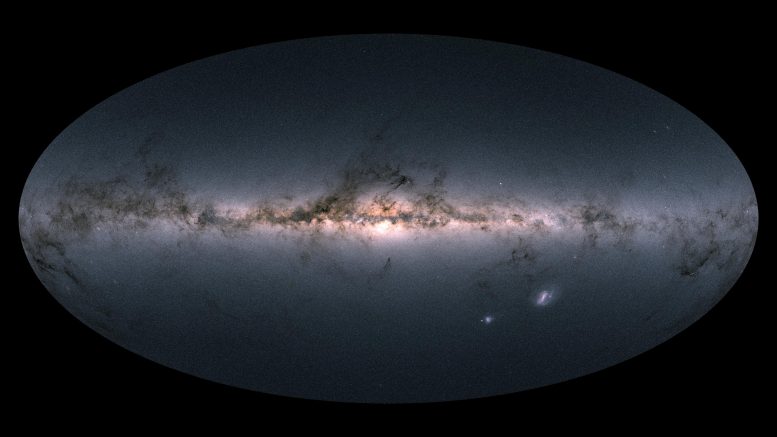By Milan P. Ilnyckyj, Canadian Institute for Theoretical Astrophysics March 8, 2024

New research challenges the traditional view of white dwarfs as mere remnants of dead stars by explaining the prolonged luminosity of delayed white dwarfs. Credit: SciTechDaily.com
Researchers discovered why some white dwarfs remain luminous for billions of years: a core process where lighter crystals rise and denser liquids sink, balancing the energy and maintaining surface brightness.
Your astronomy textbook might describe white dwarfs as the cool and comparatively uninteresting remnants of dead stars. This perspective is challenged by the previously unexplained existence of delayed white dwarfs, which defy expectations by shining as brightly as some familiar main-sequence stars for billions of years.
New research by Simon Blouin with co-authors at the University of Warwick and the Institute for Advanced Study, in Princeton, NJ reveals that in the cores of these strangely behaving stars, lower-density crystals form and float up while denser liquids with heavy impurities sink. This process of solid-liquid distillation interrupts cooling for billions of years and explains all the observed properties of the unusual population of delayed white dwarfs.
Stellar Life Cycle and White Dwarf Cooling
The lifecycle of a star begins in a gas nebula, where gravity begins to pull matter together until it is assembled in such quantities that the new sun’s core begins to fuse hydrogen nuclei together and pour light out into the universe. Eventually, most stars exhaust their nuclear fuel, shed off their outer layers into a planetary nebula, and end up as Earth-sized white dwarfs in which fusion no longer takes place.
With no fuel source for fusion, it was expected that these stars would simply cool for the rest of time. These assumptions about cooling feed into estimates of the white dwarf’s age, in turn influencing our understanding of the formation of our Milky Way.

Gaia, operated by the European Space Agency (ESA), surveys the sky from Earth orbit to create the largest, most precise, three-dimensional map of our Galaxy. This image shows Gaia’s all-sky view of the Milky Way based on measurements of almost 1.7 billion stars. Credit: ESA/Gaia/DPAC, CC BY-SA 3.0 IGO
Gaia Satellite Observations and Research Findings
The expectation of cooling white dwarfs clashes with observational data from the European Space Agency’s Gaia satellite, which showed in 2019 that a population of white dwarfs was able to apparently stop cooling for over eight billion years, which is nearly twice the age of the Earth and over half the age of the universe since the Big Bang.
The findings of Blouin and his collaborators explain the long-lasting glow of white dwarfs with the “distillation process” (light crystals forming and floating up while denser liquids sink down), which causes the release of gravitational energy. The energy output from this process almost exactly balances the energy radiated to space by the white dwarf, making its surface luminosity and temperature essentially constant.
“Going forward,” Blouin explains, “it will be important to take this mechanism into account when using white dwarfs as cosmic clocks to measure the ages of stars.”
Contributions of Simon Blouin
Simon Blouin is a Canadian Institute for Theoretical Astrophysics (CITA) National Fellow working at the University of Victoria with Professor Falk Herwig. Blouin earned his doctorate in physics at l’Université de Montréal in 2019 before completing post-doctoral fellowships at the U.S. Los Alamos National Laboratory and at UVic. His work employs a wide variety of simulation techniques to improve models of white dwarfs. This improves physicists’ and astronomers’ ability to use these stars as accurate cosmic clocks that help infer the history of stars forming in our Milky Way galaxy.
With his latest research, just published in Nature, Blouin and his collaborators identify the mechanism that keeps delayed white dwarfs hot for billions of years thus explaining the second stellar life of white dwarfs.
Reference: “Buoyant crystals halt the cooling of white dwarf stars” by Antoine Bédard, Simon Blouin and Sihao Cheng, 6 March 2024, Nature.
DOI: 10.1038/s41586-024-07102-y
Antoine Bédard, joint first author of the article, is an NSERC Postdoctoral Fellow at the University of Warwick, UK. He obtained his PhD in physics from the Université de Montréal in 2022.
Simon Blouin is a Canadian Institute for Theoretical Astrophysics (CITA) National Fellow working at the University of Victoria with Professor Falk Herwig. Blouin earned his doctorate in physics at l’Université de Montréal in 2019 before completing post-doctoral fellowships at the U.S. Los Alamos National Laboratory and at UVic.
Sihao Cheng, contributing author of the article and discoverer of the cooling anomaly in 2019, is a postdoctoral member at the Institute for Advanced Study in Princeton. He obtained his PhD from the Johns Hopkins University in 2021.
>>> Read full article>>>
Copyright for syndicated content belongs to the linked Source : SciTechDaily – https://scitechdaily.com/eternal-flames-unraveling-the-mystery-of-delayed-white-dwarfs/





























